The Carboy Market is estimated to be valued at USD 1.3 billion in 2025 and is projected to reach USD 2.2 billion by 2035, registering a compound annual growth rate (CAGR) of 5.5% over the forecast period.
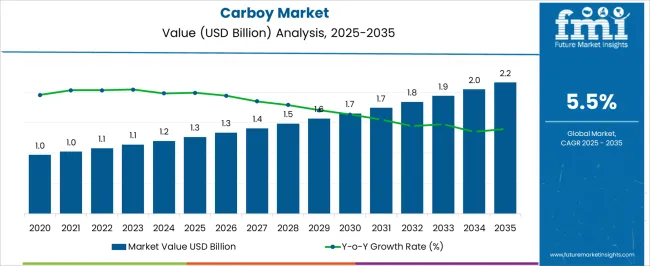
| Metric | Value |
|---|---|
| Carboy Market Estimated Value in (2025 E) | USD 1.3 billion |
| Carboy Market Forecast Value in (2035 F) | USD 2.2 billion |
| Forecast CAGR (2025 to 2035) | 5.5% |
The Carboy market is experiencing steady growth, driven by the increasing demand for safe and reliable liquid storage solutions across laboratories, industrial processes, and pharmaceutical applications. The current market scenario reflects a growing preference for containers that provide chemical resistance, ease of handling, and durability. Advancements in laboratory workflows and stricter safety protocols are shaping the future outlook of the market, leading to higher adoption of standardized carboy designs.
Investment in research and development for enhanced materials and ergonomic designs is enabling safer and more efficient liquid handling. The market is further supported by the rising number of research laboratories and analytical facilities worldwide, along with increasing awareness of contamination prevention and chemical stability.
As industries continue to prioritize operational safety and regulatory compliance, the Carboy market is positioned to witness continued expansion, with opportunities emerging from both established laboratories and emerging scientific research hubs The focus on versatile and high-capacity containers is expected to further drive adoption in the medium to long term.
The carboy market is segmented by material type, capacity, end use, and geographic regions. By material type, carboy market is divided into Glass, Plastic, Polyethylene, Polypropylene, Polycarbonate, and Others. In terms of capacity, carboy market is classified into 10 Liters To 30 Liters, Less Than 5 Liters, 5 Liters To 10 Liters, 30 Liters To 50 Liters, and Above 50 Liters. Based on end use, carboy market is segmented into Laboratories, Chemical Industry, Oil & Petroleum, Breweries, and Others. Regionally, the carboy industry is classified into North America, Latin America, Western Europe, Eastern Europe, Balkan & Baltic Countries, Russia & Belarus, Central Asia, East Asia, South Asia & Pacific, and the Middle East & Africa.
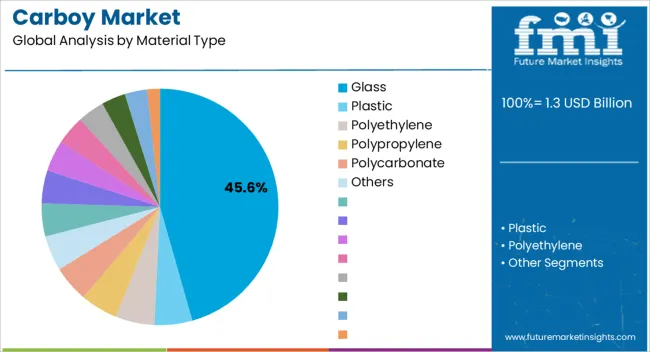
The glass material type segment is projected to hold 45.60% of the Carboy market revenue share in 2025, making it the leading material type. This dominance is being attributed to the chemical inertness, transparency, and durability offered by glass, which allows precise monitoring of stored liquids and ensures minimal risk of contamination. Adoption has been accelerated by the growing demand from laboratories that require high-purity containers for research and analytical procedures.
The ease of cleaning and sterilization, coupled with resistance to a wide range of chemicals, makes glass carboys highly suitable for repeated usage in controlled environments. The segment has also benefited from the increasing focus on sustainable and reusable laboratory equipment, which has reinforced glass as the preferred material over plastics for critical applications.
Future growth is expected to be catalyzed by laboratories and research facilities seeking containers that provide both reliability and longevity without compromising on safety standards The high adoption rate in regulated scientific environments underpins the sustained growth of this segment.
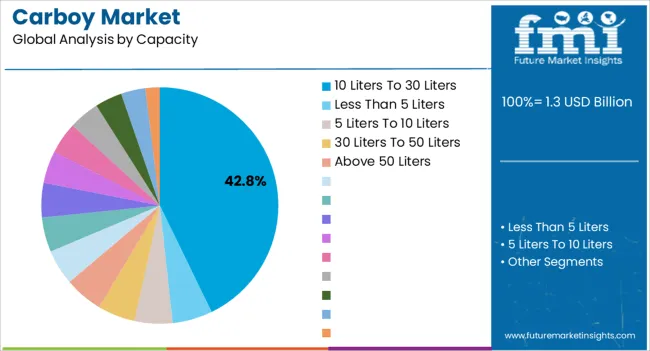
The 10 liters to 30 liters capacity segment is expected to account for 42.80% of the Carboy market revenue share in 2025, establishing it as the leading capacity range. This prominence is being driven by the need for medium-sized containers that balance storage volume with ease of handling and transport.
Adoption has been favored in laboratory settings where space constraints and operational efficiency require containers that are manageable yet sufficiently large for batch processing or experimental preparation. The versatility of this capacity range has facilitated its use across chemical, pharmaceutical, and analytical applications, where both precision and efficiency are critical.
Furthermore, the segment’s growth has been reinforced by the increasing implementation of standardized laboratory workflows that favor uniform container sizes for consistency and compatibility with automated handling systems As laboratories continue to expand and optimize their operations, the demand for 10 liters to 30 liters carboys is expected to remain strong, driven by their practicality, ergonomic advantages, and alignment with operational efficiency goals.
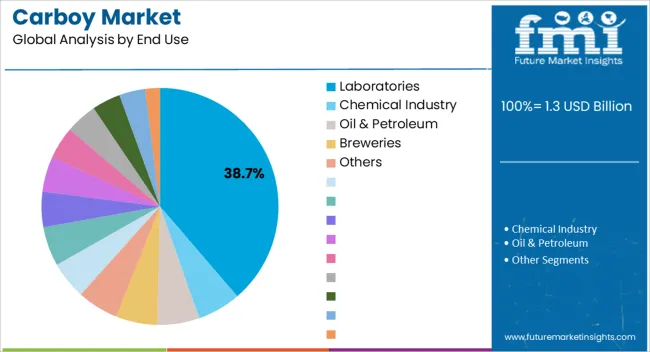
The Laboratories end-use industry segment is projected to hold 38.70% of the Carboy market revenue share in 2025, making it the leading end-use sector. This leadership is being supported by the increasing number of research, analytical, and educational laboratories globally that require safe and reliable liquid storage solutions.
Adoption has been accelerated by the critical need for contamination-free and chemically resistant containers to support experimental accuracy and reproducibility. The growth of this segment has been further influenced by rising investments in laboratory infrastructure and equipment, coupled with heightened awareness of safety and compliance standards in handling chemicals.
Laboratories favor carboys that offer ease of sterilization, chemical stability, and transparency for monitoring contents, reinforcing their role as a preferred solution As scientific research and testing activities continue to expand across healthcare, pharmaceutical, and academic sectors, the demand for laboratory-oriented carboys is expected to maintain its leading position, driven by the emphasis on operational safety, reliability, and regulatory compliance.
A carboy is a versatile container used for transportation and storage of various types of liquid including chemicals, alcoholic beverages, solutions, and corrosive liquids. It is sometimes also referred to as demijohn, a name given to a short-necked bottle. Carboy can be made up of either plastic or glass. The polyethylene, polypropylene, and polycarbonate are widely used plastic material used.
Carboys are available in various shapes and size as per the requirements. Carboy finds useful applications in industrial packaging sectors including, chemicals & fertilizers, cosmetics, breweries, pharmaceuticals, oil & petroleum among others. Apart from industrial packaging, the carboy is an important storage option in the laboratory. Carboy can be available with or without stopcock. Among brewers, the carboy is one of the most acceptable vessels used for the storage of beers and wines. The outlook for the global carboy market is supposed to be positive during the forecast period.
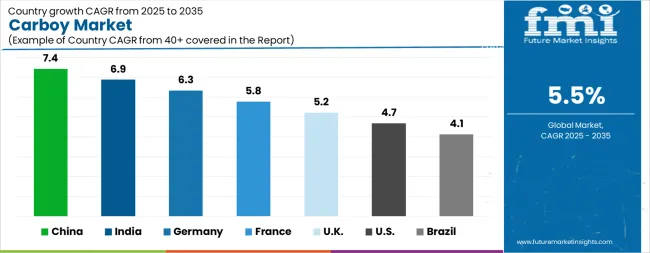
| Country | CAGR |
|---|---|
| China | 7.4% |
| India | 6.9% |
| Germany | 6.3% |
| France | 5.8% |
| UK | 5.2% |
| USA | 4.7% |
| Brazil | 4.1% |
The Carboy Market is expected to register a CAGR of 5.5% during the forecast period, exhibiting varied country level momentum. China leads with the highest CAGR of 7.4%, followed by India at 6.9%. Developed markets such as Germany, France, and the UK continue to expand steadily, while the USA is likely to grow at consistent rates. Brazil posts the lowest CAGR at 4.1%, yet still underscores a broadly positive trajectory for the global Carboy Market. In 2024, Germany held a dominant revenue in the Western Europe market and is expected to grow with a CAGR of 6.3%. The USA Carboy Market is estimated to be valued at USD 436.1 million in 2025 and is anticipated to reach a valuation of USD 688.7 million by 2035. Sales are projected to rise at a CAGR of 4.7% over the forecast period between 2025 and 2035. While Japan and South Korea markets are estimated to be valued at USD 62.2 million and USD 40.3 million respectively in 2025.
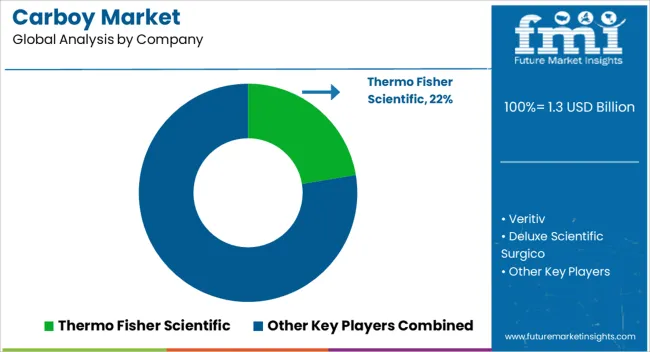
| Item | Value |
|---|---|
| Quantitative Units | USD 1.3 Billion |
| Material Type | Glass, Plastic, Polyethylene, Polypropylene, Polycarbonate, and Others |
| Capacity | 10 Liters To 30 Liters, Less Than 5 Liters, 5 Liters To 10 Liters, 30 Liters To 50 Liters, and Above 50 Liters |
| End Use | Laboratories, Chemical Industry, Oil & Petroleum, Breweries, and Others |
| Regions Covered | North America, Europe, Asia-Pacific, Latin America, Middle East & Africa |
| Country Covered | United States, Canada, Germany, France, United Kingdom, China, Japan, India, Brazil, South Africa |
| Key Companies Profiled | Thermo Fisher Scientific, Veritiv, Deluxe Scientific Surgico, Marin Scientific Development, Metro Ace Innovplas, Globe Scientific, Subhang Capsas, Sterlitech, Qorpak, KIMBLE, Wiegand-Glas, Vetreria Etrusca, Veralia, BEATSON CLARK, Linlang (shanghai) Glass Products, and Gilac |
The global carboy market is estimated to be valued at USD 1.3 billion in 2025.
The market size for the carboy market is projected to reach USD 2.2 billion by 2035.
The carboy market is expected to grow at a 5.5% CAGR between 2025 and 2035.
The key product types in carboy market are glass, plastic, polyethylene, polypropylene, polycarbonate and others.
In terms of capacity, 10 liters to 30 liters segment to command 42.8% share in the carboy market in 2025.






Our Research Products

The "Full Research Suite" delivers actionable market intel, deep dives on markets or technologies, so clients act faster, cut risk, and unlock growth.

The Leaderboard benchmarks and ranks top vendors, classifying them as Established Leaders, Leading Challengers, or Disruptors & Challengers.

Locates where complements amplify value and substitutes erode it, forecasting net impact by horizon

We deliver granular, decision-grade intel: market sizing, 5-year forecasts, pricing, adoption, usage, revenue, and operational KPIs—plus competitor tracking, regulation, and value chains—across 60 countries broadly.

Spot the shifts before they hit your P&L. We track inflection points, adoption curves, pricing moves, and ecosystem plays to show where demand is heading, why it is changing, and what to do next across high-growth markets and disruptive tech

Real-time reads of user behavior. We track shifting priorities, perceptions of today’s and next-gen services, and provider experience, then pace how fast tech moves from trial to adoption, blending buyer, consumer, and channel inputs with social signals (#WhySwitch, #UX).

Partner with our analyst team to build a custom report designed around your business priorities. From analysing market trends to assessing competitors or crafting bespoke datasets, we tailor insights to your needs.
Supplier Intelligence
Discovery & Profiling
Capacity & Footprint
Performance & Risk
Compliance & Governance
Commercial Readiness
Who Supplies Whom
Scorecards & Shortlists
Playbooks & Docs
Category Intelligence
Definition & Scope
Demand & Use Cases
Cost Drivers
Market Structure
Supply Chain Map
Trade & Policy
Operating Norms
Deliverables
Buyer Intelligence
Account Basics
Spend & Scope
Procurement Model
Vendor Requirements
Terms & Policies
Entry Strategy
Pain Points & Triggers
Outputs
Pricing Analysis
Benchmarks
Trends
Should-Cost
Indexation
Landed Cost
Commercial Terms
Deliverables
Brand Analysis
Positioning & Value Prop
Share & Presence
Customer Evidence
Go-to-Market
Digital & Reputation
Compliance & Trust
KPIs & Gaps
Outputs
Full Research Suite comprises of:
Market outlook & trends analysis
Interviews & case studies
Strategic recommendations
Vendor profiles & capabilities analysis
5-year forecasts
8 regions and 60+ country-level data splits
Market segment data splits
12 months of continuous data updates
DELIVERED AS:
PDF EXCEL ONLINE
Plastic Carboy Market
Dispensing Carboy Market Size and Share Forecast Outlook 2025 to 2035
Market Share Breakdown of Dispensing Carboy Providers

Thank you!
You will receive an email from our Business Development Manager. Please be sure to check your SPAM/JUNK folder too.
Chat With
MaRIA